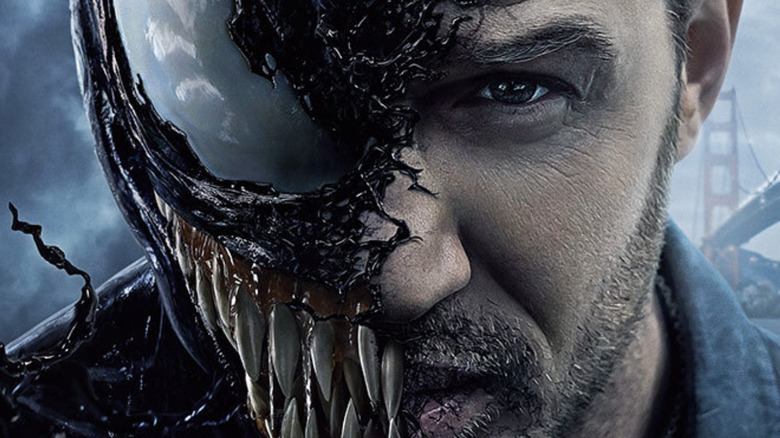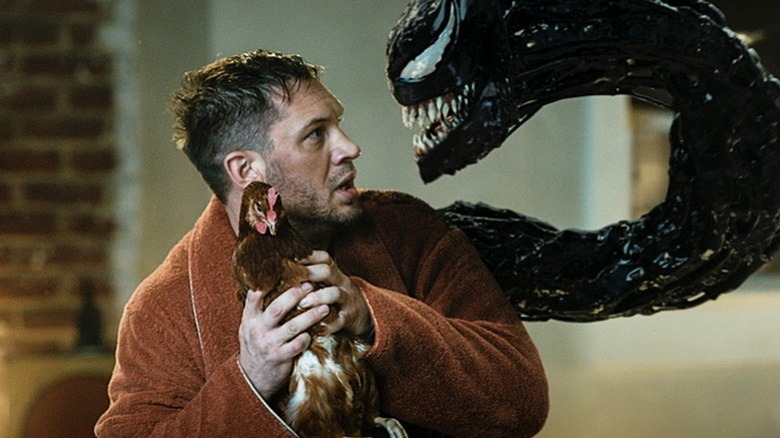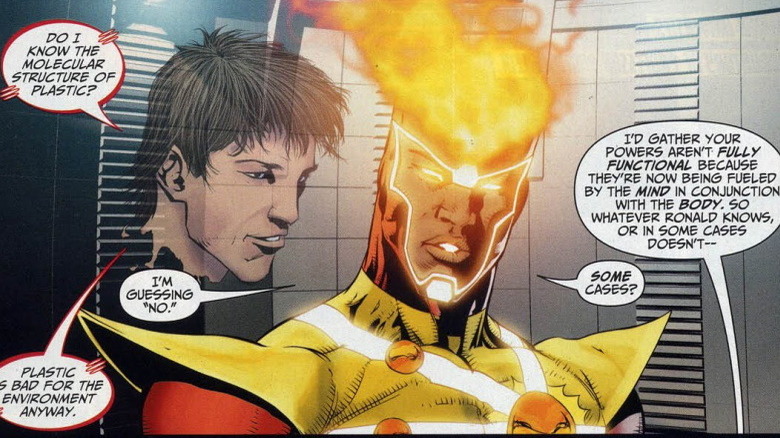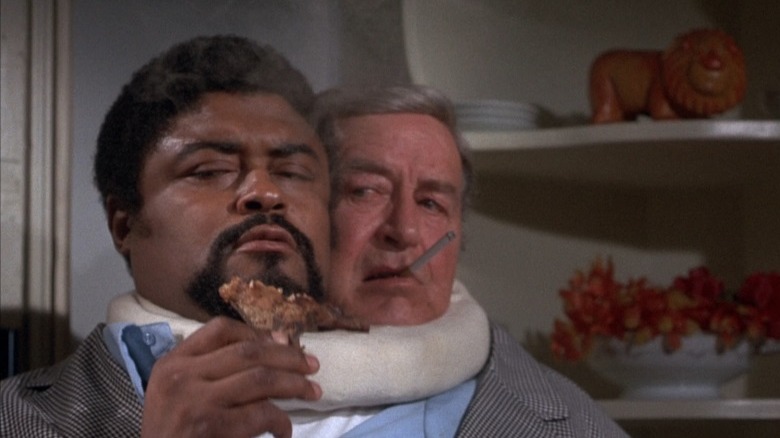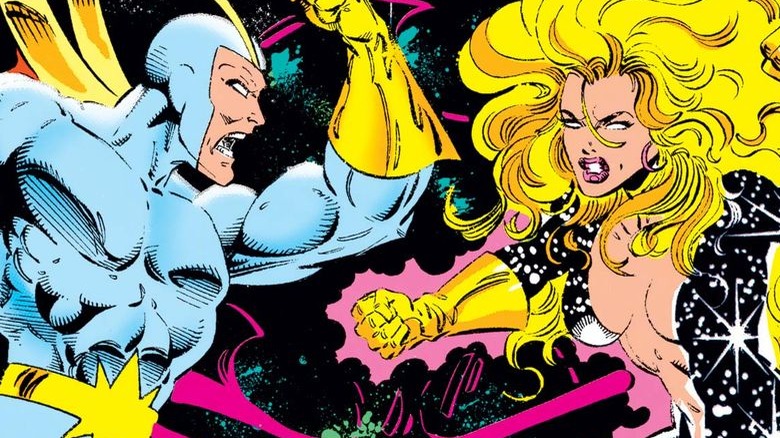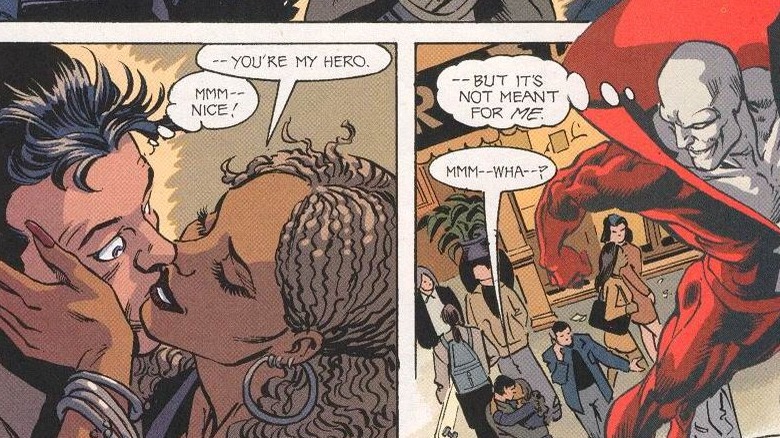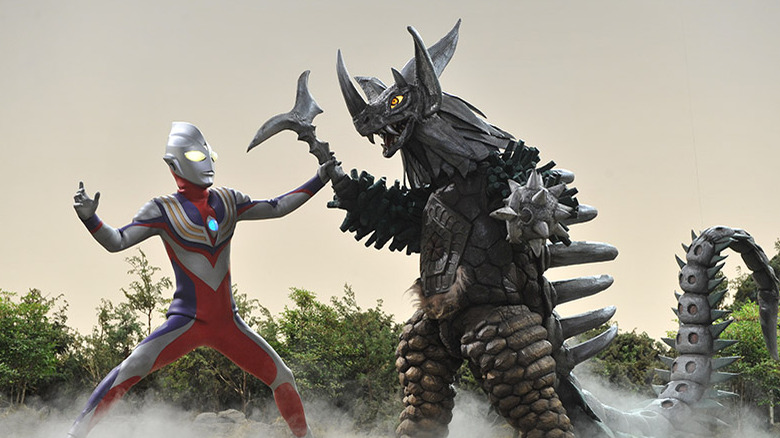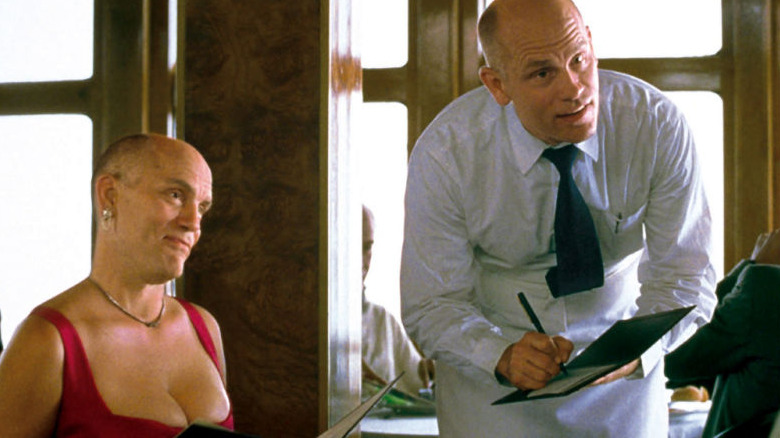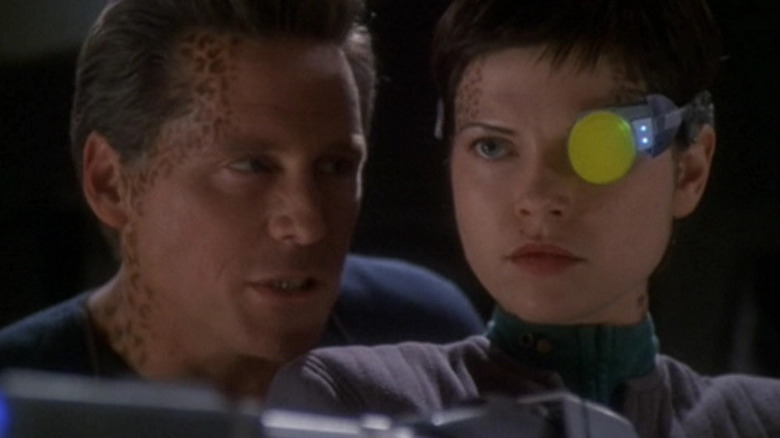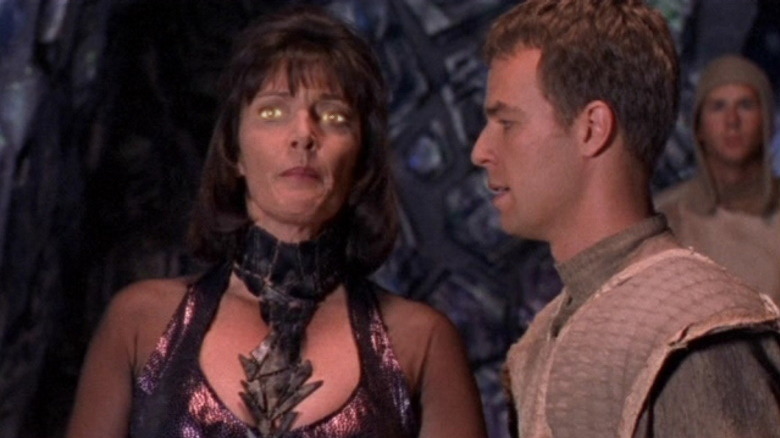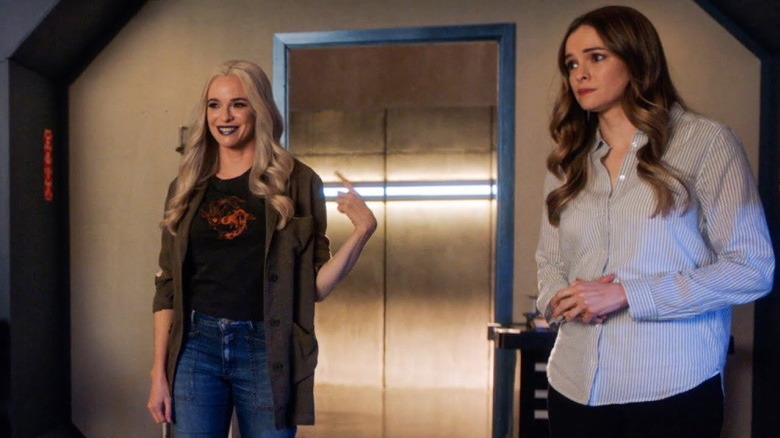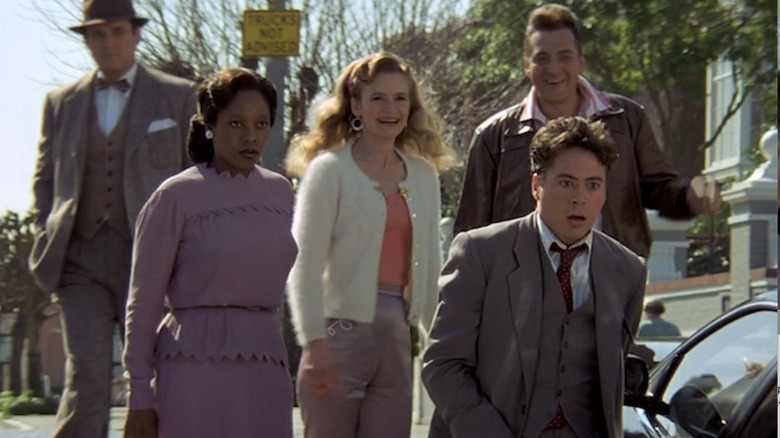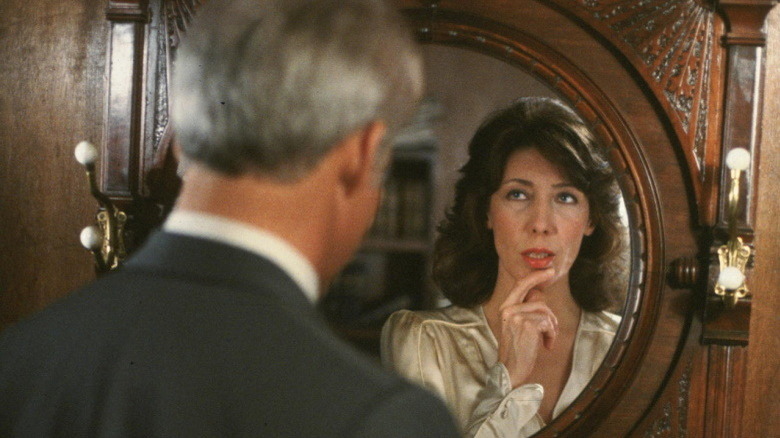Best Movie And TV Characters Who Share A Body
They say that two heads are better than one — although, for cinematic superheroes, aliens, ghosts, demons and other beings, it can often be quite an inconvenience.
Being of two minds means having to make some major lifestyle changes. That's because these folks don't just put their heads together; they quite literally share a body.
How these things happens in movies can vary wildly. Sometimes, it's simply the way their species and culture have functioned for thousands of years. Other times, it's the result of some science experiment gone horribly wrong (or right, depending on your point of view). And on some other occasions, these two-in-one beings function as a living cautionary tale of what might happen if you sold your soul to the devil or made other equally questionable life choices.
However it happened, seeing two beings attempting to navigate the trials and tribulations of sharing a body can be a lot of fun — and meaty material for both drama and comedy alike. Read on for a breakdown of the closest relationships in cinematic history.
Venom
Let's start with everyone's favorite brain-eating symbiote: Venom. Since he first appeared in "The Amazing Spider-Man" #299, Venom has gone through numerous retcons. Originally an alien symbiote who bonded with Spider-Man, Venom gained a new human host in disgruntled ex-reporter Eddie Brock, who evolved from a villain to an anti-hero to the savior of mankind when he stood with humanity against the evil symbiote god Knull.
Curiously, the symbiote itself remained largely silent in most of its initial appearances. Although Eddie chatted with his alien "other," readers could never hear the alien talk back in early comics. Even when Venom made his big screen debut in Sam Raimi's "Spider-Man 3" (2007), he largely let his human host Eddie Brock Jr. (Topher Grace) do the talking for them.
This changed when Venom was rebooted as a Sony franchise starring Tom Hardy. Taking on the roles of Eddie Brock and Venom in 2018's "Venom," Hardy showed considerable skill while depicting the unhinged relationship between the alien and the human, with Venom and Eddie bonding after realizing they are both the "losers" of their respective species. After Eddie comes to enjoy the power he gets from Venom, the two partner up to become their own weird brand of superhero.
By the time of the 2021 sequel "Venom: Let There Be Carnage," Eddie and Venom found themselves in full "Odd Couple" mode, with Venom cooking Eddie breakfast and giving him advice for dealing with emotional pain after his ex-girlfriend left for another man.
Firestorm
Radiation exposure has been a tried-and-true method for gaining superpowers in comic books and TV shows, but when Ronnie Raymond got caught in one of those nuclear accidents that always plague the DC Universe in "Firestorm: The Nuclear Man" #1, he got something a little extra. It seems that Nobel Prize-winning physicist Martin Stein was also in that accident, and the radiation fused the two together into the composite being "Firestorm." Now possessing the power to rearrange matter at an atomic level, the hybrid hero also discovered he had Martin Stein living in his head as a sort of disembodied consciousness.
Since that time, many other people have entered the "Firestorm Matrix." Ronnie and Martin had to share space with the Russian Mikhail Arkadin after an atomic bomb fused him with their bodies. Later, Ronnie died and a new kid, Jason Rusch, merged with Martin Stein to create a new Firestorm. For a while, Jason was even able to become Firestorm by merging with any random person he happened to come across, making his transformations incredibly inconvenient for pizza delivery drivers.
Elements of the Firestorm mythos have made their way into live action TV in recent years via "The Flash" and "Legends of Tomorrow." Here, Martin Stein (Victor Garber) gets to become Firestorm initially by fusing with Ronnie Raymond (Robbie Amell), but later finds a different host in Jax Jackson (Franz Drameh). The two form a close relationship, but when Stein dies, Jax goes his own way.
The Thing with Two Heads
One of the most infamous B-movies ever made, "The Thing with Two Heads" (1972) depicted a racist white scientist named Dr. Maxwell Kirshner (Ray Milland), who gets his head transplanted onto the body of African-American convict Jack Moss (Rosey Grier) — while Jack's original head is still attached. What follows is a very creepy story that has Kirshner gradually gaining control over Jack's body and plotting to have his head removed. The two end up going on the run, making this one of the more disturbing "buddy road trip" movies.
Considered something of a cult classic today, "The Thing with Two Heads" has been referenced in other TV shows, particularly "The Simpsons" episode "Treehouse of Horror II," where Homer's boss Mr. Burns got himself attached to Homer's body following an accident. Later, in "Treehouse of Horror XXIV," Bart Simpson's own head would be grafted onto his sister Lisa's shoulder.
Starhawk
Sibling relationships took on a whole new dimension of weird in the late '70s, via Marvel Comics' cosmic hero "Starhawk." In "Marvel Presents" #9-10, archeologist Stakar and his adoptive sister Aleta explored the ruins containing a "Hawk God," becoming merged into a single being with energy manipulating and precognitive powers. Things got even more bizarre when Stakar and Aleta fell in love and separated briefly so they could have three children together. Is anyone else getting "Game of Thrones" vibes from this pair?
That wasn't even the weirdest part of their history. Aleta and Stakar had a falling out after their kids became psychic vampires, then Aleta fell in love with Vance Astro, the leader of a 31st century version of the Guardians of the Galaxy. Vance wasn't thrilled about his girlfriend being in the body of a man, but things seemed to work out when Stakar regressed back into a fetus and Aleta became a female version of Starhawk.
In the movies, Stakar showed up in "Guardians of the Galaxy Vol. 2" (2017), played by none other than Sylvester Stallone. Meanwhile, Aleta also made a brief appearance, played by Michelle Yeoh. No word yet on whether or not these two will "come together" like their comic book counterparts.
Ghost Rider
If there's one thing comic books have taught us, it's that deals with the devil never turn out well. Just ask motorcycle stuntman Johnny Blaze, who tried to get the demon Mephisto to save his dying step-father in 1972's "Marvel Spotlight" #5, only for Mephisto to merge Blaze with the demon Zarathos. Johnny became the Ghost Rider, a leather-clad anti-hero with a blazing skull and supernatural motorcycle. Johnny and Zarathos sometimes conversed on a mental plane, with neither being particularly happy being saddled with the other.
Things weren't much better for Danny Ketch, the Ghost Rider of the 1990s, who fused with his ancestor Noble Kale to become a new "Spirit of Vengeance" in "Ghost Rider" #1. Although Noble wasn't the evil demon Zarathos was, he could be extremely brutal, and Danny was often sickened by what he did when the Ghost Rider took over his body at night.
Ghost Rider made his way into movies via Nicolas Cage in 2007's "Ghost Rider" and 2012's "Ghost Rider: Spirit of Vengeance," as the world's most beloved over-emoter portrayed the anti-hero. Weirdly, Zarathos is recast here as an angel — "The Spirit of Justice" — that Johnny helps purify into his original divine state. The Ghost Rider later showed up in the "Agents of SHIELD" TV series, where he passed on his demonic powers to a different host — car mechanic Robbie Reyes (Gabriel Luna). With so many human hosts, who know who the Spirit of Vengeance will merge with next?
Deadman
Up next is a ghost who needs your body to become a superhero — the ever-entertaining Deadman. Originally Boston Brand, a high-flying circus acrobat, this death-defying showman found his career cut short (literally) in 1967's "Strange Adventures" #205 when a hook-handed man took a shot at him while he was doing his trapeze act. Offered a chance to track down his killer and gain justice for his own murder, "Deadman" was given the power to possess other people, enabling him to interact with the living.
Thanks to his ghostly powers of invisibility and intangibility, Deadman could easily spy on the wicked and uncover their evil schemes. When it came time to fight, however, this spectral superhero literally needed to borrow the bodies of others to beat up villains. While this could be inconvenient for whatever random stockbroker or college student he jumped into, it did offer them some fringe benefits — just imagine how cool you'd look to your friends if you suddenly started leaping and spinning like a hyperactive Jackie Chan. Just don't expect to give them any repeat performances ... and be sure to stock up on ligament medicines for later.
Although Deadman hasn't appeared in a movie or TV series yet, there are rumors a film could be in some stage of development. And honestly, at this point, if you haven't seen a movie yet starring your favorite comic book character, you just need to check back in a few months.
Ultraman
In Japan, getting caught in the middle of a giant kaiju monster attack is a surefire way to leave you squished or incinerated — unless you happen to be found by one of the "Ultras" — god-like benevolent aliens charged with maintaining peace and order throughout the universe. Then there's a good chance your recently dead corpse will be revived to become the human host to one of the most powerful beings in the galaxy.
For most of the time, you'll look and act like you normally do. However, the second a giant monster attacks Earth, you can whip out your handy transformation capsule and morph into a giant silver guardian with nearly unlimited power. Just make sure you destroy the monster in three minutes. That's how long an Ultraman can survive on Earth before reverting to human form.
That's the premise of many "Ultraman" TV shows (also known as the Ultra Series), which saw seemingly ordinary men and women merge with powerful alien giants to become a force for good. In recent years, Marvel Comics has reimagined many of those early stories, showing scenarios where an Ultra continues to telepathically offer its human host useful advice even when it's not fighting. Now that's a cool partner to have!
John Malkovich
No, your eyes don't deceive you — actor John Malkovich has indeed share his body with another person. In fact, he has shared his body with several other people — at least, according to the metafictional fantasy-comedy "Being John Malkovich" (1999).
This Spike Jonze/Charlie Kaufman classic followed unemployed puppeteer Craig Schwartz (John Cusack) as he stumbled upon a mysterious door in his office leading directly into the mind of John Malkovich. Desperate and longing for the attention of a girl named Maxine (Catherine Keener), he devises an innovative business plan — charge people money to spend time as Malkovich for fifteen minutes at a time (after which they're ejected onto the side of the New Jersey Turnpike). Everything seems to work out great — until Malkovich gets wise to all these newcomers in his brain and orders that Craig stop renting out his headspace.
Things become more sinister once the movie reveals that the portal is being used to make Malkovich a host body for multiple elderly people who want to attain immortality by permanently merging with him. Eerily enough, they succeed. Quirky, crazy and hilarious, "John Malkovich" is a head trip.
Jadzia Dax
Body-stealing aliens have been a popular trope in science fiction for a long time. However, in the progressive "Star Trek" universe, becoming the host to an alien isn't something to be scared of — it's an honor that grants you lifetimes of knowledge.
At least that's the way the alien Trill see things. On their world, dominant lifeforms are classified into two separate groups: humanoid beings who look very much like us (aside from some fashionable spots), and a race of worm-like alien symbiotes that can physically join with humanoids and experience their entire lives. Upon death, the symbiote separates from its host and bonds with a new Trill, granting him or her all the knowledge and talents of its previous hosts.
Naturally, this is one heck of a way to enhance your education. Just ask Jadzia Dax (Terry Farrell), a Trill woman with the body of a supermodel and three hundred years-worth of collected knowledge. Incidentally, the Trill don't segregate between male or female hosts, meaning Jadzia knows exactly what it's like to be both a man and a woman.
Curiously, while Jadzia typically considers all her previous hosts to be part of her overall whole, some "Star Trek: Deep Space Nine" episodes like "Facets" and "Field of Fire" show Trill can perform special rites that call up the personalities of early hosts, allowing them to manifest as ghost-like beings or possess the bodies of others. This gives "talking to yourself" a whole different meaning.
Tok'ra
The symbiotic aliens of the "Stargate" universe are unusual in that they're technically not symbiotes at all, but parasites. Originally part of the Goa'uld species that takes over the minds of sentient hosts and consider themselves to be gods, the Tok'ra found such parasitic practices to be morally wrong and formed their own group. Only taking volunteers as hosts, the Tok'ra can also cure diseases like cancer and arthritis and even double a human's normal lifespan.
While Goa'uld completely dominate their hosts, the Tok'ra believe their hosts have a right to continue living their own lives and willingly relinquish control over their bodies in the interest of establishing a genuinely symbiotic relationship. Many human hosts even consider the symbiotes to be good company, forming positive relationships with them.
On the downside, the Tok'ra don't have a queen, meaning their numbers are in short supply. Given that these guys are such a rare resource and offer so many physical benefits, they \ might be the only parasite you'd be happy to get.
Caitlin Snow/Killer Frost
Ever since the "The Three Faces of Eve" and "Sybil," split personalities have been a popular trope in movies and TV, with everyone from the Incredible Hulk to Two-Face showcasing different fictional versions of multiple personality disorder. In "The Flash" TV series, however, Dr. Caitlin Snow (Danielle Panabaker) finds her alternate personality "Killer Frost" is much more than what she initially seems.
For the first couple seasons, Caitlin was a brilliant but non-powered scientist who helped Barry Allen (Grant Gustin) with his superhero activities. In Season 3, however, she develops cryokinetic powers and a form of dissociative identity disorder that causes her to become the deadly supervillain "Killer Frost." Initially attempting to suppress her alternate identity, Caitlin gradually warms up to her other self, even discovering in Season 4 that she first manifested her Frost persona as a child, meaning they've been "together" longer than first suspected.
By Season 6, Caitlin allows "Frost" to come out and socialize more, leading to her developing a more well-rounded personality. Caitlin even becomes annoyed that some of her co-workers seem to prefer hanging out with Frost over her. The two become so independent that by Season 7, they're separated into two different bodies thanks to an encounter with the Mirror Monarch's Mirror gun. Frankly, there are easier ways to get a twin sister — but you have to admit, this is more fun.
Thomas Reilly
Long before he invented the Iron Man armor, Robert Downey Jr. played a living suit of armor for four people in "Heart & Souls" (1993). In this lighthearted comedy, ghosts with unfinished business are linked to a newborn baby, who can function as their go-between to the living when he or she grows up. Unfortunately, nobody explained this to recently deceased Julia (Kyra Sedgwick), Penny (Alfre Woodard), Milo (Tom Sizemore), or Harrison (Charles Grodin), who find themselves the unwitting "imaginary friends" of young Thomas Reilly (Downey).
Deciding they're a disruptive influence on the life of Thomas, the four choose to become invisible to him. Sadly, the trauma of their sudden abandonment causes Thomas to grow up into a ruthless banker who avoids close relationships. When the four souls learn they can possess the body of Thomas and resolve their unfinished business, however, they reappear and convince him to help.
This results in each ghost inhabiting the body of Thomas long enough to steal back some priceless stamps to earn Milo redemption, sing onstage to fulfill Harrison's dream, and even track down Penny's children. Remarkably, these misadventures also serve to heal some of their host's own emotional wounds, showing the give-and-take that exists in every healthy relationship. Even ones with ghosts.
Roger Cobb/Edwina Cutwater
Sharing a body successfully requires a lot of cooperation between two minds — but this was hilariously harder for Steve Martin and Lily Tomlin in the 1985 comedy-fantasy "All of Me."
When the spirit of recently-deceased rich woman Edwina Cutwater (Tomlin) gets transferred into the body of attorney Roger Cobb (Martin), she discovers she has control over the right side of his body. This results in some hilarious struggles between the two, as highlighted in the infamous "little fireman" scene.
Roger and Edwina eventually manage to come to an understanding, trying to get Edwina's soul transferred into Terry Hoskins (Victoria Tennant), a young woman with a troubled past. Of course, this being a comedy, Edwina's soul gets displaced into a lot of other places — including Roger's blind friend Tyrone (Jason Bernard) and a pitcher of water — before the situation resolves itself. Frankly, becoming the host body of an alien symbiote sounds easy by comparison.
